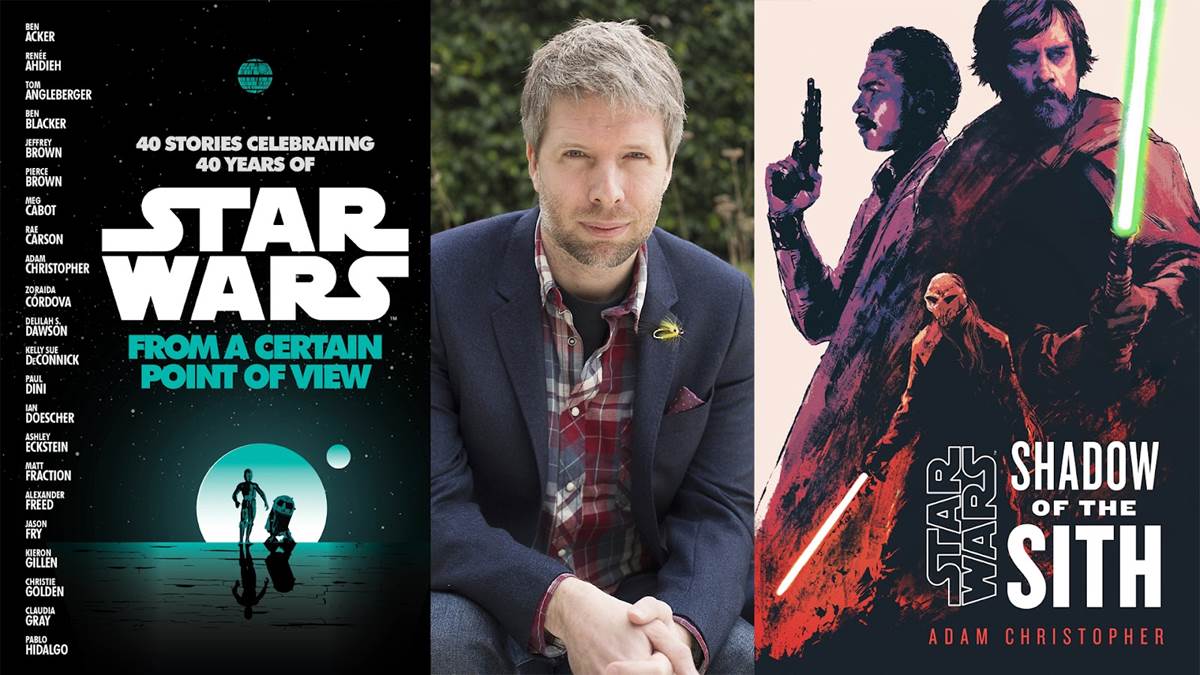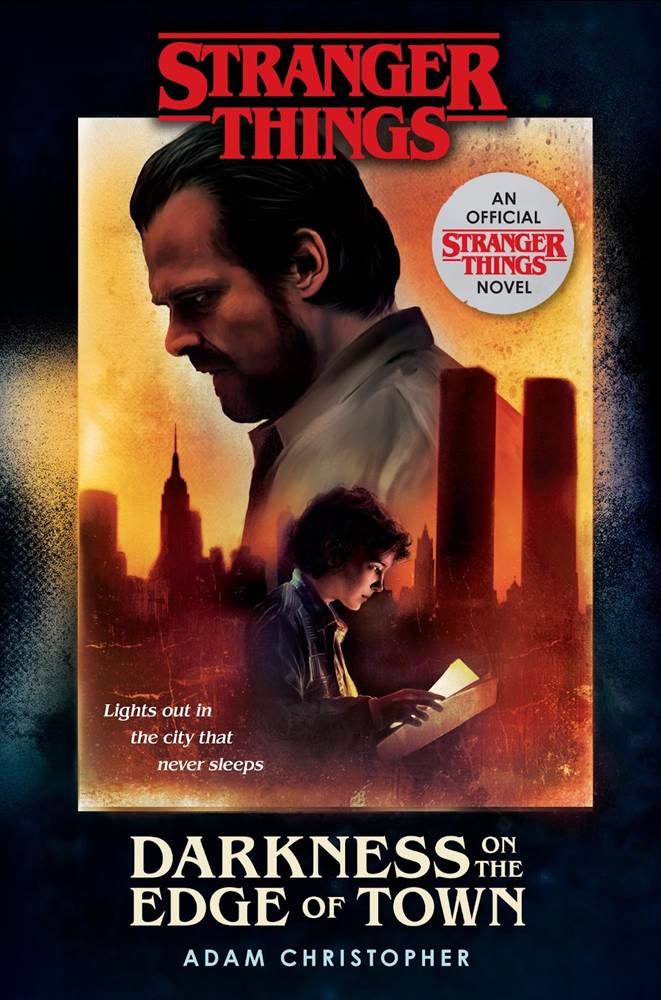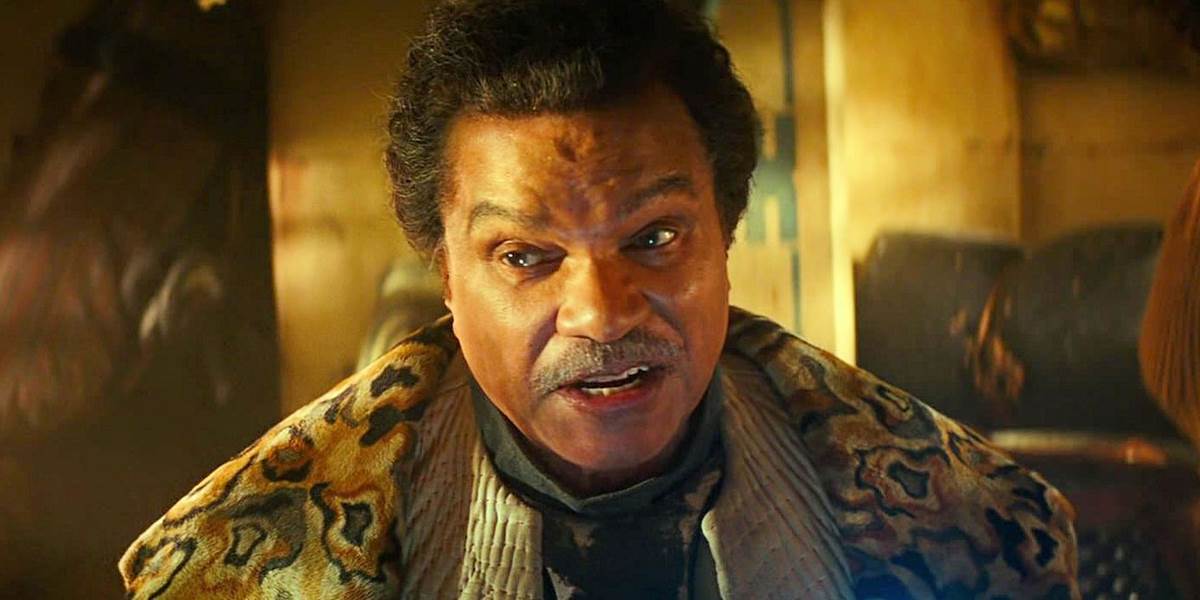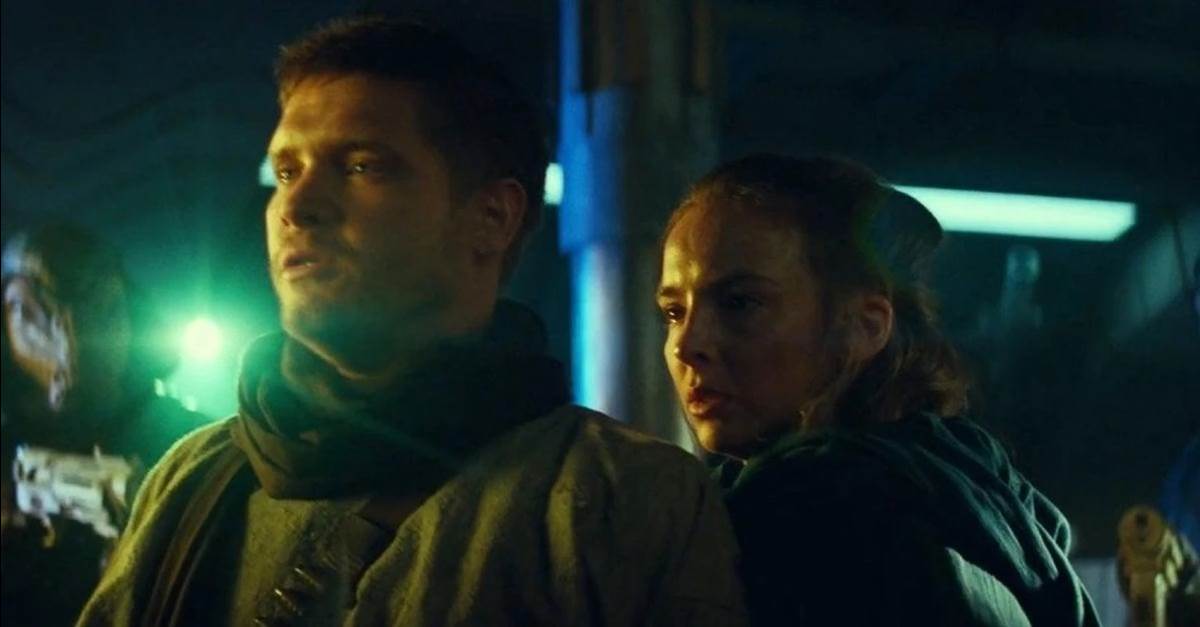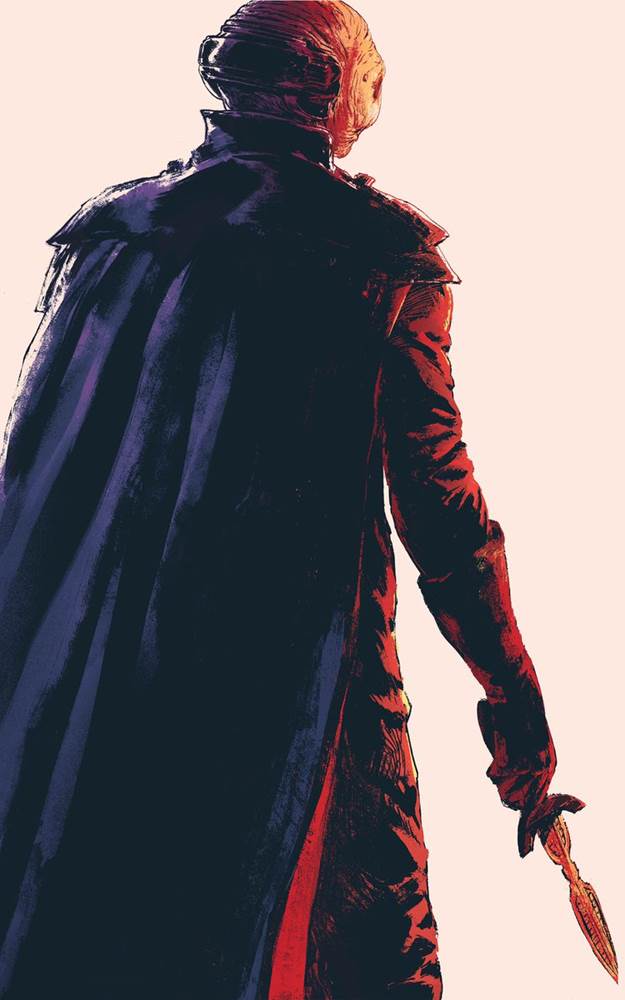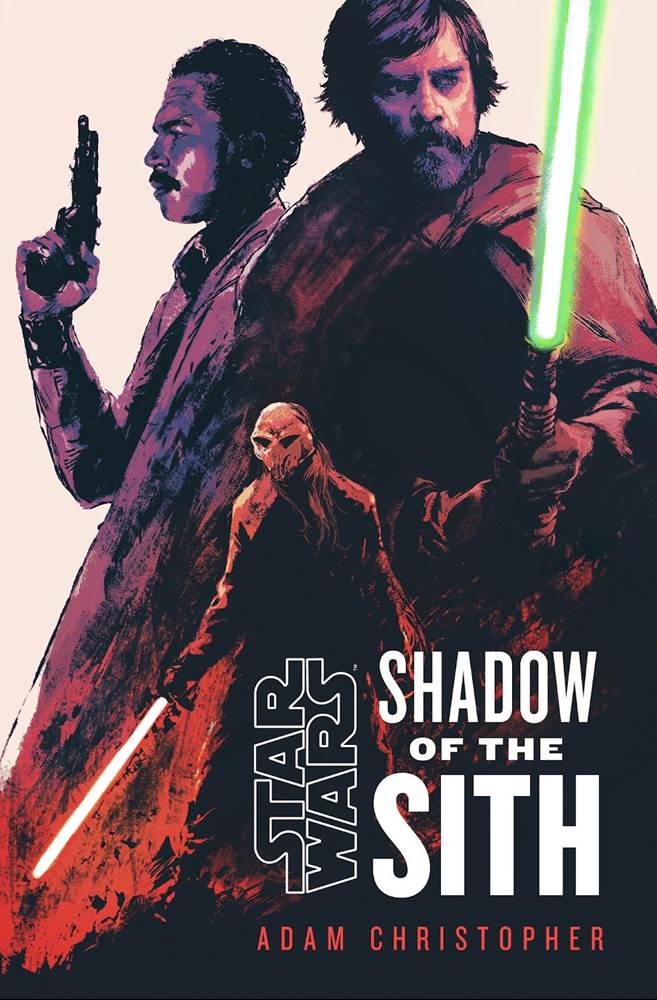New Zealand-born novelist Adam Christopher has been professionally writing genre fiction for over a decade, having published acclaimed books such as Seven Wonders, Hang Wire, the Empire State series, and the Ray Electromatic Mysteries. He has also contributed tie-in novels to the Dishonored video game universe, CBS’s Elementary series, and Netflix’s smash-hit Stranger Things franchise. In 2017 he began working with Lucasfilm Publishing on the short-story anthology collections Star Wars: From a Certain Point of View, and last year he penned his first full-length novel set in a Galaxy Far, Far Away with Star Wars: Shadow of the Sith.
Last week in London, Adam Christopher was gracious enough to take an hour out of his busy weekend at Star Wars Celebration Europe 2023 to appear on the panel for Laughing Place’s Star Wars podcast “Who’s the Bossk?” Below is an abridged transcript of our conversation about his writing career and what it was like breaking into the world of Star Wars publishing. The full audio from this interview was featured in Episode 150 of “Who’s the Bossk?”
Mike Celestino, Laughing Place: How did you first get interested in writing?
Adam Christopher: This is a cliche answer that every author gives, but I have always written. I started writing at school when I was like seven, because we did it at school. There was this particular teacher at primary school who was a failed novelist or something, but we did it. And what I was doing at seven years old was watching Doctor Who on TV and I was writing Doctor Who fanfiction, probably to the bewilderment of that teacher. I’ve still got some of it, too. But I think because Doctor Who has that book history, that’s what I wanted to do from the beginning. I watched it on TV, I read the books, and then I wrote my own fiction, which was, at that age– apart from being terrible– just a mishmash of what I was watching. I can identify the stories I was watching when I was writing. So I always did that, and then I wrote Doctor Who fanfiction properly as I got older, and the first stuff I ever had published in fanzines was Doctor Who fanfiction. There’s a couple of fanzines in New Zealand that took it, and I had the cover. They did a special fiction issue– this was about 1994, and I got the cover! Someone drew a picture from my story, which was amazing. And [the fanzine had] a circulation of like 200 people. It’s not huge.
And then I went to university and was too busy [to write], but I always had that urge. Then I was actually moving to the U.K. in 2006, [and there was] this publisher. Publishers normally don’t take anybody’s submissions. You need an agent or something to submit, but there was a science-fiction publisher that did an open window, which meant that anybody could send in a proposal– a synopsis and chapters– and get a book deal. Of course, I was so convinced of my genius that I wrote a proposal and some chapters and sent [it] to them completely expecting to be picked up. This was right when I was moving, because I submitted it in New Zealand before we left, and then a few months after we arrived [in] the U.K., I got the rejection, which was completely appropriate because what I sent was trash. It was just awful. But it was weird, because it flicked a switch in my brain, and I thought, ‘Okay, if I want to do this properly, I’ve got to really take it seriously. If I want to do it as a job, it’s got to be my number-one thing that I do.’ So I was like, ‘Okay, what do I do? I need to work out how to write books and how to do it properly and tell stories.’ My Doctor Who fanfiction had been short stories. I mean, fanfiction is amazing, and people write huge books and series and everything, but mine was always short.
So my wife helped me with resources– ‘How do I learn this kind of stuff and what support can I get?’ And I found a podcast called ‘The Secrets’ by Michael A. Stackpole– one of the big New York Times bestselling Star Wars authors [of] X-Wing: Rogue Squadron and I, Jedi. He had this thing called ‘The Secrets,’ which was [about] how to write. It’s writing advice and craft, that kind of thing. I would listen to that as a podcast on the way to work on the bus, and I thought, ‘Let’s see what I can do.’ So I wrote a book as a full-length manuscript– the first time I’d ever done it. And again, [it was] completely terrible, but I finished it. Obviously I had no intention that that would actually get published, but it was like, ‘Yes, I can write a book.’ And then I did the next one, and the next one, and the next one, and just kept going. And then it was probably the third one I had written I realized was good enough for someone else to look at. I met a publisher on Twitter– I didn’t have an agent– and they took the book. I sold it without an agent, which is kind of the wrong way around to do it.
LP: How do you get from that point to working with Lucasfilm Publishing?
Christopher: Writing tie-in books is very difficult to get into– not for any nefarious reasons or gatekeeping or anything, but because there are very tight deadlines and there’s a lot of pressure on it. What they’re looking for [in] people to write these books is someone who can be given a brief, [and] write the book to deadline– 100,000 words of cohesive story [and] logical narrative with characters that people like and will feel emotions about. It has to make sense and be well-written, and then if it’s a novel in a tie-in world, it has to do all those things and also fit into a tie-in universe, whether it’s Star Wars or Doctor Who or Stranger Things or whatever. Especially with something as big as Star Wars, you’re using characters that people have known and loved for 40 years. They have to know that you can get it absolutely right, because if you get it wrong, people are going to know instantly. We’ve all probably read bad tie-in novels that have somehow got through. You can tell, if you’re a fan of [the franchise], ‘Well, this doesn’t read right.’
The rule of thumb is ten years of traditional publishing before you get invited to this kind of thing. The first tie-in I did was Elementary, which is that modern-day Sherlock Holmes TV show. I did two novels for Elementary, and I got that because I had sold a space-opera trilogy to a publisher in the U.K., and I went down for lunch with the editor, as you do. Then while I was down there, they were talking to this other editor about the problems they were having with Elementary. And I knew that the publisher did other tie-ins– they did Marvel and DC stuff as well, and movie tie-ins, all kind of things. I was like, ‘Elementary is my favorite TV show at the moment, so I’d really love to write an Elementary book.’ They wouldn’t give it to me. Being a Doctor Who fan, I wanted to write tie-ins. It’s different to writing original work, because with original stuff you can control it. You own the copyright, you do your own thing. Three months later, my agent emailed and said, ‘Do you still want to do Elementary? Something’s happened; the guy can’t do the books. They need the first book in three weeks.’
This was my first tie-in, so this is where I plant the flag and show that I can do it. I had to do an audition chapter for CBS, because they were obviously worried. The audition chapter had to have Sherlock Holmes and Watson– the main characters, and it had to show that I understood what Elementary was and what the format and the style of the show was. So I did that and the synopsis, and they’re like, ‘Go for it.’ So yeah, three weeks for the first book. That was probably five or six years into my career– by that point I had four or five books published of my own original fiction. I was not famous, but people knew who I was and what I could do. It was really good, because I did Elementary, and then I did three books for Dishonored, which is a video game series. I had to connect these different games together– again, more practice. I was aware, ‘This is tie-in work.’ And then I got Stranger Things, [which] was edited by the Star Wars team at Del Rey– it’s the same people. Then they did the From a Certain Point of View anthologies, so my first Star Wars thing was the story in the first one, which was cool.
LP: How did you come up with your story ‘End of Watch’ for Star Wars: From a Certain Point of View?
Christopher: I wrote the point-of-view of the Imperial officers who take the other side of the conversation when Han is like, ‘We’re all fine here. How are you?’ I did it kind of seriously, because [Robot Chicken] did a really amazing take off it. I was aware that there was a funny version, so I did a serious one where it’s just about the Imperial officers doing their job, and they get this weird call. People don’t know what’s going on– someone talks about the princess, and everyone in the Imperial control room are going, ‘What princess?’ Because the Death Star is enormous, and why would they [be clued in to what’s going on]? And then they have to call Tarkin. When you break it down to write a story, the dialogue is actually kind of weird. That was the whole point– it’s a bureaucracy, and not everyone knows what’s going on because it’s so huge. And you wouldn’t [as an Imperial officer], because you’re not Vader or Tarkin. But that was really fun to do.
That was my very first bit of Star Wars, and then after that I got Star Wars Adventures, which is the IDW all-ages comic. I did an issue of that– that was specific: they wanted a minor sequel-trilogy character to do an eight-page one-shot story. I chose Tallissan Lintra from The Last Jedi– she’s the A-wing pilot who leads the bombing raid at the beginning, and then she gets blown up in the hangar, which really sticks in my craw. She’s a young woman, she’s a really great pilot, and a leader. And in a series of movies– especially the Original Trilogy– where there isn’t much diversity of representation, to blow up Tallie Lintra was [frustrating]. I was like, ‘I’m gonna one day write Tallie Lintra.’
LP: Then you get to From a Certain Point of View: The Empire Strikes Back.
Christopher: Yeah, that was weird, because I was going to do a Mandalorian novel. I got the call to do The Mandalorian novel on the day the U.K. went into its first lockdown for COVID, so that was a really weird day. The Prime Minister was on TV telling us that we couldn’t go outside, and I got an email saying, ‘Here’s The Mandalorian novel.’ That was a strange day. So for whatever reason, we didn’t do that. But I was late coming into The Empire Strikes Back: From a Certain Point of View because they were trying to sort the contract out for The Mandalorian. I came in quite late… for the first one I chose the story, because obviously that’s a classic scene. Someone had to do it, so I did it. For The Empire Strikes Back, because I came in late, there weren’t many gaps where I could fit a story. But they really really wanted to have the final moment between Vader and Luke: ‘I am your father.’ This is the most iconic moment in cinema history, probably, in popular cinema– a foundation scene in Star Wars. The problem with it [was] there’s no one else there. There’s Vader and there’s Luke, and they’re on that gantry in Cloud City. And there’s no one there.
The whole point of From a Certain Point of View is [that it’s] from the point-of-view of someone who is watching or is associated [with the main action], but there’s no one there. So I had to come up with a way of inserting a character, which I did. I had a stormtrooper who gets lost. [laughs] She’s one of the stormtroopers that torture Han; she’s got doubts about what she’s doing because she’s not quite so indoctrinated [as her peers]. She leads Han to the freezing chamber– she’s on-screen. [Then] she wanders off and gets lost, and she’s actually in that sub-control room when Vader’s using the Force to throw all the equipment at Luke and Luke goes out the window. She’s actually hiding behind one of the consoles, and then to escape the maelstrom of the storm, she takes a panel off and gets into the crawlspace. I mapped it out– I got all the art books and concept designs. There’s an access door that you see in the movie, and she’s actually at the door. You couldn’t have a character like my stormtrooper who got lost suddenly overhear the most important line in cinema history, so I did it [as] because it’s so windy and chaotic, she doesn’t hear all of the conversation. She hears bits, and she’s like, ‘What’s happening out there?’ It’s super fun.
LP: In Shadow of the Sith, you were tasked with the goal of bridging the gap between the Original Trilogy and the sequel trilogy. How did this come about for you and what was your initial approach to this story?
Christopher: When The Mandalorian couldn’t happen, [Del Rey was] like, ‘Well, we’ve got this other book.’ [It’s] the story of that moment in The Rise of Skywalker where Rey meets Lando, and Lando’s like, ‘Me and Luke went on this adventure chasing Ochi of Bestoon, looking for a Sith Wayfinder.’ ‘Go away and write that story.’ That was the entire brief. Again, because I had established myself, and I had done Stranger Things, which was quite a big book for them, they could trust me to just go and write the story. I just had a completely blank canvas. The first thing I did was rewatch the sequel trilogy, and then as I was writing the book, I went through the sequels frame-by-frame at points to get stuff. In the flashbacks in The Rise of Skywalker where we see Rey’s parents, it’s about ten seconds, you see Ochi of Bestoon. And when Ochi kills Dathan, Rey’s dad, I emailed the [Lucasfilm] Story Group, and I was like, ‘Who’s the two people in the background?’ And they were like, ‘What people in the background?’ If you freeze-frame, there’s two aliens standing behind Dathan, so in the book they became Bosvarga and Cerensco, who are two of Ochi’s minions.
They get on the wrong end of Ochi’s temper, which was to explain in The Rise of Skywalker when they go to Ochi’s ship and it’s all dusty and decrepit. It’s got those shutters at the front– I think Finn or Poe opens the shutters, and there’s a huge blood spatter across them. That’s the remains of Bosvarga. It’s little things like that, which as a Star Wars geek you can put in. It doesn’t really matter, but it’s cool to do. I’m the kind of Star Wars fan where I do that– I’ll go through the Original Trilogy frame-by-frame. In Return of the Jedi, who [are] all the creatures in Jabba’s Palace? I’d pause and try to match them up with the action figures. I was doing that with the VHS. That kind of super-geeky Star Wars thing I went to town with, but my job is to write a good Star Wars story. And I treated it as though I was writing Episode 6.5, because it was set between Return of the Jedi and The Force Awakens. It was really important because I had Luke and Lando in it, and Luke books are rare in Star Wars publishing. I was aware that a lot of people wanted a Luke Skywalker book, and they were expecting quite a lot from it. Star Wars books are really good because you can do character things– maybe it’s one character’s origin story or profile. Or maybe it’s a story that fits somewhere in the storytelling very specifically, to link things together. But because I had such a wide span of time to use, I [thought], ‘Let’s make a movie,’ basically.
LP: In the first few chapters of Shadow of the Sith, we learn not only the names of Rey’s parents, but also the name of the planet where Luke Skywalker’s Jedi academy is located, which was derived from Legends. How much leeway were you given with the naming of these very important elements of the Star Wars mythos? Were these suggestions from the Story Group?
Christopher: Actually, I was lucky– most of it was from me. I knew that Rey’s parents were going to be main characters in the book– they carry half the story, so they obviously had to have names. There was even a joke where there were Star Wars trading cards [that] had Rey’s parents on them, but it just said, ‘Rey’s mom [and] Rey’s dad.’ We had seen them on screen, but they had no existence beyond that. So I was like, ‘Okay, I need some names.’ Part of me was aware that I was creating Star Wars canon… to create Rey’s parents, that’s huge, really. The Rise of Skywalker novelization by Rae Carson goes into a lot of extra detail about Palpatine’s cloning– more so than you see in the [movie]. It’s actually logical; it goes right back to Revenge of the Sith– ‘Have you ever heard the tragedy of Darth Plagueis the Wise?’ The whole thing about Palpatine is that he’s trying to live forever, and the whole thing about the Sith is that they can’t let go of the past– which is why Sith can’t become Force ghosts.
To be a Force ghost, you have to let go of everything and be one with the Force, and move on. The Sith cannot move on, and Palpatine is the ultimate representation of that. He thinks he’s learned the secret of immortality from his master Plagueis– which then we’ve now seen in The Mandalorian, the whole cloning thing. So I created Rey’s parents, I created where Rey came from– the planet Hyperkarn. It was good stuff. Ossus was funny because I needed the name of the planet that Luke’s temple was on, and they said, ‘That name exists, and we can’t give it to you yet.’ That’s a clue that they were going to include it in something. They didn’t tell us anything. [I got to] a really late draft of the book, and I’m like, ‘I need the name of the planet.’ And they were like, ‘Okay, it’s Ossus,’ which is from the old [Expanded Universe], and Shadow of the Sith is the first place it’s mentioned in canon. Little details like that, if it ties in directly to something they can’t tell you about, then they tell you what to do– to put it in. Otherwise, Rey’s parents’ names I just came up with.
LP: When it came to a character like Ochi of Bestoon, who was established in The Rise of Skywalker and then expanded upon in Greg Pak’s Darth Vader comics, how did you draw from those sources to flesh him out?
Christopher: I was really lucky with Ochi, because my book is set I think 17 years after Return of the Jedi, and the Vader comic that [he] appears in is set between The Empire Strikes Back and Return of the Jedi. I had a huge gap, so following what Greg Pak had done in the comic, I was able to also create my own version of Ochi. We see him much later, and obviously he’s been through a really bad time and he’s changed quite a lot. He’s still got that shadow of his former glory from the comics, which is completely amazing, and not what you’d expect a Sith assassin to be. This is the whole thing– he’s not what you’d expect. He’s a bit of a disaster, really. [laughs] And then we see him in Shadow of the Sith; he’s clearly the same person, but stuff has happened. He’s still a disaster and it still goes way wrong [for him]. Basically he brings about his own destruction because he’s Ochi of Bestoon. He’s cool; he was good to write, as well. He was fun.
LP: How about some of the other characters that you chose to pull in from other material, like Lor San Tekka and Beaumont Kin? How did they come to be included in the novel?
Christopher: I wanted to link things. I’ve got Shriv, who’s a video game character who’s a friend of Lando’s, because it made sense that Lando would go to somebody to get information. The person he’d go to is Shriv, and Shriv appears in the video game [Star Wars: Battlefront II]. Now it doesn’t matter if you haven't played the video game or seen the cutscenes or whatever. He’s a friend of Lando’s, and he appears in the book. Lor San Tekka is in The Force Awakens as the old guy who gives the map to Poe. He’s [also] in The Rise of Kylo Ren comic by Charles Soule, and that establishes that he is helping Luke search the galaxy for [Jedi] relics. Well, the whole book is about relics, so it was going to be Lor San Tekka [showing up]. It was logical. I wasn’t going through Wookieepedia going, ‘Who shall I pick? What obscure character can I put in?’ It was all logical. Beaumont Kin, who is played by Dominic Monaghan, he appears in The Rise of Skywalker; he’s a scholar. Well, if he’s a scholar of Sith relics, at what point did he get interested in [that]? He must have encountered them, therefore he could be in the book. He’s doing an archaeological dig and Lor comes and visits. My favorite chapters are actually with Pryde, who’s played by Richard E. Grant in The Rise of Skywalker. Pryde is an amazing character, and he’s got a whole two chapters in the book, because he’s just so amazing. But again it made sense, because there’s a connection between Ochi and the Imperial remnant that leads up to what we then see in the sequel trilogy. This is like 13 years before the sequel trilogy. It’s all logical, I think.
Star Wars: Shadow of the Sith is available now in paperback wherever books are sold.

